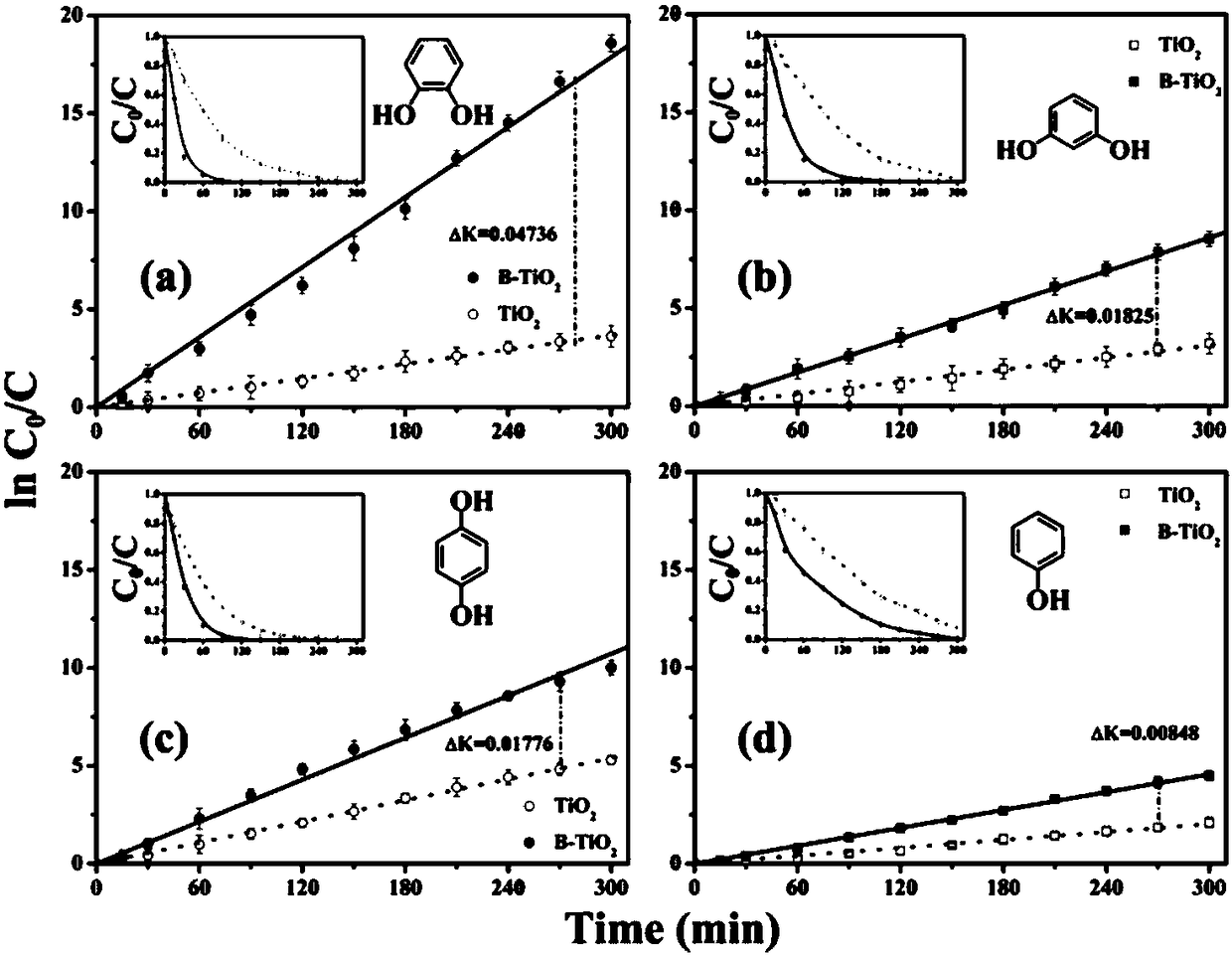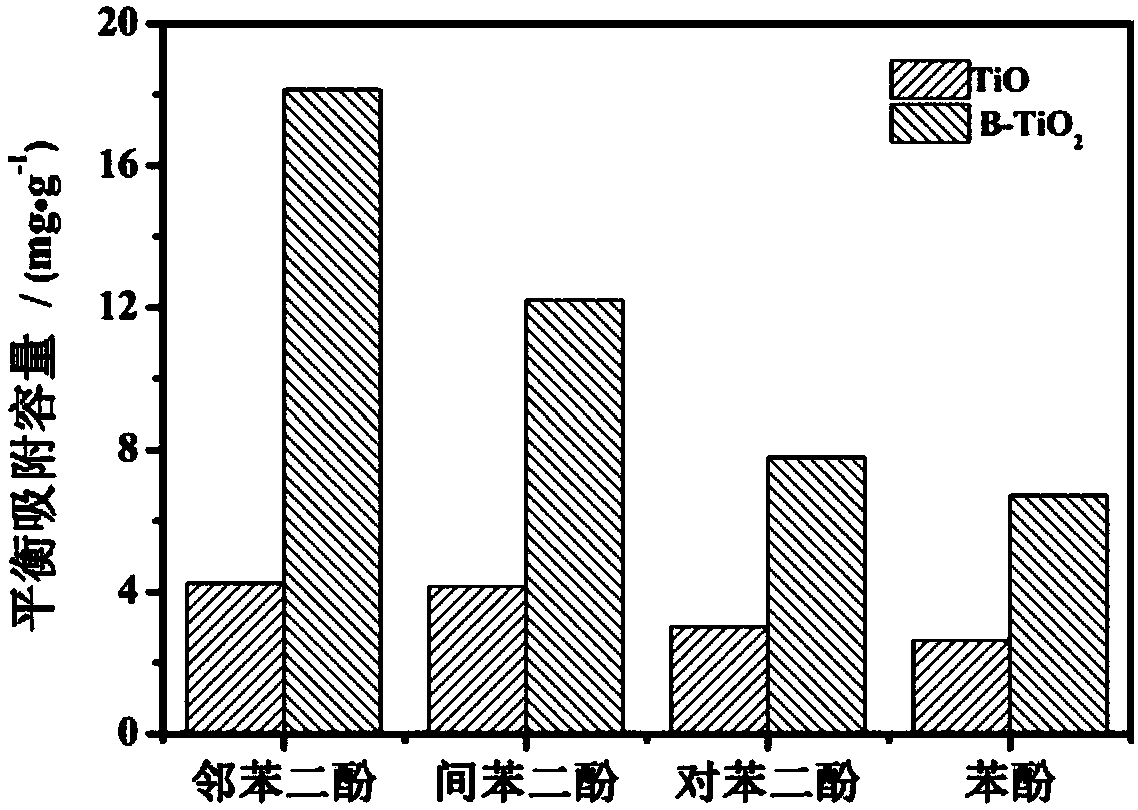Preparation method of interstitial boron doping titanium dioxide photocatalytic material and application
A photocatalytic material, titanium dioxide technology, applied in chemical instruments and methods, physical/chemical process catalysts, nanotechnology for materials and surface science, etc., can solve problems such as complex methods and poor material reusability, and achieve catalytic The effect of high efficiency, simple and feasible method, high-efficiency enrichment and fast oxidation kinetics
- Summary
- Abstract
- Description
- Claims
- Application Information
AI Technical Summary
Problems solved by technology
Method used
Image
Examples
Embodiment 1
[0026] An interstitial boron-doped TiO for efficient enrichment and rapid oxidative degradation of phenols with different structures 2 The specific preparation steps of nanomaterials are as follows:
[0027] (1) Weigh 2.0 g of boric acid, 10 g of absolute ethanol and 0.1 g of acetic acid, pour the three into a 50 ml beaker, stir and mix evenly, and mark it as solution 1. Then the solution 1 was put into a mixture of ice and water at 0°C and cooled. After the temperature of solution 1 drops to 0° C., measure 20 g of tetrabutyl titanate and slowly add it to solution 1 dropwise, marking this mixed solution as solution 2.
[0028] (2) Put the solution 2 into a constant temperature oven at 30-50°C for sol-gel and aging process, and the aging time is 12-24h. After completing the sol-gel and aging, take out the white gel solid, wash the white gel solid with absolute ethanol and deionized water successively, and repeat the washing three times.
[0029] (3) Put the cleaned white gel solid i...
Embodiment 2
[0032] Interstitial boron TiO prepared by the method of Example 1 2 And pure TiO 2 Nano particles are used as photocatalytic materials. Deionized water was used to prepare catechol, resorcinol, hydroquinone and phenol solutions with a concentration of 20 mg / L. The four phenols were photocatalyzed and degraded by ultraviolet light irradiation. The dosage of the catalyst is 1g / L. Such as figure 1 As shown, after the photocatalytic degradation time is 4 hours, the interstitial boron doped TiO 2 The degradation kinetic rate constants of catechol, resorcinol, hydroquinone and phenol are 0.05769 min-1, 0.04713 min-1, 0.02864 min-1 and 0.01281 min-1, respectively. Pure TiO 2 The degradation kinetic rate constants of catechol, resorcinol, hydroquinone and phenol are 0.01381min-1, 0.01003min-1, 0.01825min-1 and 0.00658min-1, respectively. This example shows that B -TiO 2 It has a more efficient and rapid photocatalytic oxidation rate for low-concentration phenol in water.
Embodiment 3
[0034] Use the interstitial boron-doped TiO prepared in Example 1 2 And pure TiO 2 Nano particles are used as photocatalytic materials. Configure a 50mg / L solution of catechol, resorcinol, hydroquinone and phenol in a 50ml temperature-controllable photocatalytic reaction cell. Stir it evenly with a magnetic stirrer. Take a little sample and save it for testing. As the initial concentration value of the four phenols. Then add 50mg of interstitial boron doped TiO 2 And pure TiO 2 The nanocrystal is configured as a suspension system with an adsorbent content of 1.0g / L. During the magnetic stirring process, samples are taken at different time intervals to analyze the concentration of residual phenol in the solution. Such as figure 2 As shown, after 2h static adsorption, the interstitial boron doped TiO 2 The maximum equilibrium adsorption concentrations of hydroquinone, resorcinol, hydroquinone and phenol solutions were 18.38 mg / L, 12.53 mg / L, 7.363 mg / L, and 6.670 mg / L, respecti...
PUM
| Property | Measurement | Unit |
|---|---|---|
| particle diameter | aaaaa | aaaaa |
Abstract
Description
Claims
Application Information
 Login to View More
Login to View More - R&D
- Intellectual Property
- Life Sciences
- Materials
- Tech Scout
- Unparalleled Data Quality
- Higher Quality Content
- 60% Fewer Hallucinations
Browse by: Latest US Patents, China's latest patents, Technical Efficacy Thesaurus, Application Domain, Technology Topic, Popular Technical Reports.
© 2025 PatSnap. All rights reserved.Legal|Privacy policy|Modern Slavery Act Transparency Statement|Sitemap|About US| Contact US: help@patsnap.com


